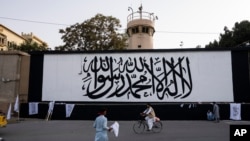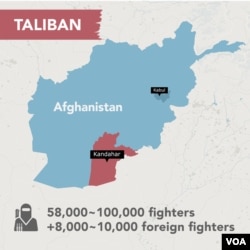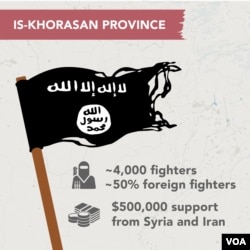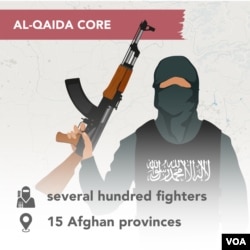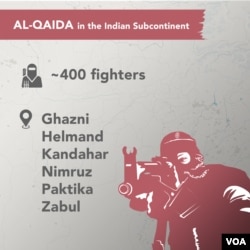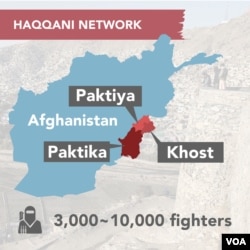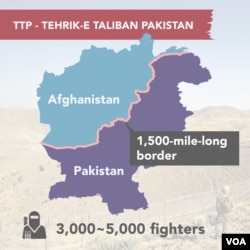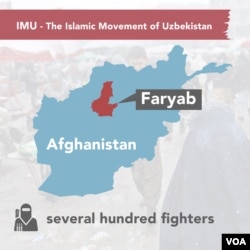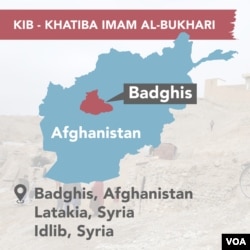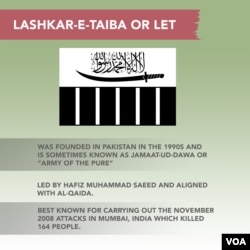Intelligence agencies worldwide are warning that Taliban rule in Afghanistan is radically reshaping terrorist and militant groups in South Asia and around the world.
Specifically, intelligence and counterterrorism officials say that despite Taliban promises to sever ties with al-Qaida and oppose terror groups such as the Islamic State's Afghan affiliate, as codified in the 2020 Doha agreement with the United States, there has been scant evidence of progress.
"The Taliban is attempting to maintain pressure on ISIS [Islamic State group]," the top general at U.S. Central Command told lawmakers in Washington on March 15. "They're finding it difficult to do."
"They're much less firm on the al-Qaida issue, in terms of opposing them and trying to limit them," CENTCOM's General Kenneth "Frank" McKenzie added.
A recent United Nations report based on member state intelligence echoed those fears.
"There are no recent signs that the Taliban has taken steps to limit the activities of foreign terrorist fighters in the country," the report said. "On the contrary, terrorist groups enjoy greater freedom there than at any time in recent history."
Despite such concerns, some diplomats, such as the U.S. special representative for Afghanistan, have expressed hope the Taliban will crack down.
Thomas West told the U.S. Institute of Peace on Feb. 15 that he believed the Taliban were "very sincere in their intent to contain" Islamic State terrorists.
Here is a look at the Taliban and the major terrorist organizations now operating in Afghanistan, and how they have fared in the six months since U.S. and coalition forces left the country.
Taliban
Since its emergence in 1994, the Taliban movement, which calls itself the Islamic Emirate of Afghanistan, has been led by an emir, a central figure ostensibly appointed for life by a religious council of Taliban leaders.
Like his two predecessors, the current emir, Hibatullah Akhundzada, has made no public speeches and leads a reclusive life in southern Afghanistan's Kandahar province. He has left the management of day-to-day government affairs to his appointed caretaker Cabinet in the Afghan capital, Kabul.
Various estimates by U.S. intelligence agencies and United Nations member states put the number of Taliban fighters between 58,000 and 100,000, with numbers fluctuating according to the time of year and battlefield conditions.
A U.N. report issued in June 2021, prior to the U.S. withdrawal, noted the Taliban force size was "robust in spite of significant attrition rates" over the past few years.
The Taliban have also benefited from the presence of some 8,000 to 10,000 foreign fighters in Afghanistan, most of whom are aligned with the Taliban. The Taliban's defense minister recently said in an interview that the group is trying to build a 110,000-strong army.
Intelligence shared publicly by the United States and United Nations member states further accuses the Taliban of continuing to work closely with al-Qaida and maintaining ties with other terrorist groups, pushing some to become part of a new Taliban-run Afghan military force.
And even if the Taliban are planning to crack down on cells of IS-Khorasan, Islamic State's affiliate in Afghanistan, they may not have the right capabilities.
"I don't think what we'll see from the Taliban will be traditional [counterterrorism] as we think of it," Colin Clarke, director of research at the global intelligence firm The Soufan Group, told VOA last year.
"It's much easier to play a spoiler role than to perform effectively in the role of counterinsurgent," he said. "I think the Taliban could be effective in clearing an area, but it will struggle more with holding it."
For their part, Taliban officials have publicly denied that terrorism is an issue for Afghans under their leadership.
"We do not see anyone in Afghanistan who has anything to do with al-Qaida," Taliban spokesperson Zabihullah Mujahid told a news conference in Kabul last September.
"The ISIS that exists in Iraq and Syria does not exist here," he added. "We are committed to the fact that from Afghanistan, there will not be any danger to any country."
Islamic State Khorasan Province
The Islamic State terror group's Afghan affiliate is a sworn enemy of both the Taliban and al-Qaida, which has deep and long-standing ties to Taliban leadership. But IS-Khorasan is also one of the groups that has benefited the most from the Taliban takeover.
As Taliban forces asserted control over Afghanistan, they emptied out many of the country's prisons, including the Parwan prison at Bagram Airfield, which had held hundreds of IS-Khorasan fighters.
Taliban commanders quickly executed former IS-Khorasan leader Abu Omar Khorasani, but many other IS followers were allowed to escape.
At the time, U.S. military officials said the prison releases helped swell IS-Khorasan's ranks from several hundred to at least 2,000 "hardcore" fighters. IS-Khorasan was also blamed for the August 26 bombing at Kabul airport that killed 13 Americans and more than 170 Afghans.
Intelligence shared by U.N. member states suggests that since then, IS-Khorasan has nearly doubled in size, to about 4,000 fighters, half of which may be from outside Afghanistan.
The same intelligence estimates say that the group, which lost all the territory under its control in early 2020, now "controls limited territory in eastern Afghanistan" and that it is "capable of conducting high-profile and complex attacks."
IS-Khorasan also appears to be benefitting from financial support from its core in Syria and Iraq, receiving more than $500,000 over the past six months, according to some intelligence estimates.
U.S. defense officials have further voiced concern about IS-Khorasan regenerating the capability to launch attacks against the U.S. and other foreign targets, initially warning that the group could launch global operations starting in April 2022.
More recent assessments by U.S. military intelligence officials indicate that the group is more focused at the moment on cementing its support within Afghanistan itself and that IS-Khorasan may not be ready to carry out external operations for another 12-18 months.
Al-Qaida core
Since its initial statement at the end of August congratulating the Taliban on its victory, al-Qaida leadership has been mostly silent on the situation in Afghanistan, though al-Qaida leader Ayman al-Zawahiri referenced "the defeat of the Americans" in a video released this month.
Zawahiri himself is believed to be hiding in Afghanistan, and intelligence agencies from a number of countries assess he is in ill health.
Intelligence shared with the U.N. for a recent report, however, indicates al-Qaida is benefitting from "a significant boost" due to the U.S. withdrawal and Taliban takeover of Afghanistan.
"Some of its [al-Qaida's] closest sympathizers within the Taliban now occupy senior positions in the new de facto Afghan administration," according to the U.N. report, which also says chances are now good that Zawahiri's likely successor, Saif al-Adel, will seek to leave Iran and establish himself in Afghanistan.
Western counterterrorism estimates from before the Taliban takeover of Afghanistan suggested the al-Qaida core perhaps commanded several hundred fighters across at least 15 Afghan provinces. And in September, a top U.S. intelligence official said that there were "indications of some potential movement of al-Qaida [officials and followers] to Afghanistan," though, he cautioned, "It's still early days."
While U.S. officials remain concerned that al-Qaida will focus again on conducting foreign attacks, a recent report based on U.S. military intelligence assessments indicates that the group has been keeping a low profile at the Taliban's request, and that the Taliban, who are seeking to gain international recognition for their new government, are likely to dissuade al-Qaida leaders from launching attacks.
Al-Qaida in the Indian Subcontinent
One of al-Qaida's key offshoots, al-Qaida in the Indian Subcontinent, has as much of a presence in Afghanistan as the group's core.
Intelligence estimates from U.N. member states say AQIS has up to 400 fighters in Afghanistan, spread across Ghazni, Helmand, Kandahar, Nimruz, Paktika and Zabul provinces.
AQIS fighters, including native Afghans and fighters from Bangladesh, Pakistan, India and Myanmar (Burma), are said to have fought alongside Taliban against the U.S.-backed government prior to its collapse. Earlier U.S. intelligence assessments said it appeared that AQIS fighters were actively integrated into Taliban units.
AQIS leader Osama Mehmood and AQIS deputy Atif Yahya Ghouri are both thought to reside in Afghanistan.
Haqqani network
The Haqqani network is widely considered to be the most influential and strategically successful extremist group in the region. While nominally loyal to the Taliban, the network, as described by the U.N., is "semi-autonomous," maintaining ties with both al-Qaida and IS-Khorasan.
The group boasts a "highly skilled core of members who specialize in complex attacks and provide technical skills, such as improvised explosive device and rocket construction," according to the U.N.
It also oversees a force of between 3,000 and 10,000 traditional armed fighters in Khost, Paktika and Paktiya provinces.
The network is run by Sirajuddin Haqqani, a son of the late mujahedeen commander and network founder Jalaluddin Haqqani. For much of its existence, the group has been based in Pakistan's tribal areas as it operated across the border in Afghanistan. The more than 40-year-old Haqqani has a $10 million bounty on his head from the U.S. government and works as a deputy emir of the Taliban as well as the interior minister of Afghanistan.
The Haqqanis have been accused of perpetuating some of the deadliest and most sophisticated attacks against U.S., Indian and former Afghan government targets in Afghanistan since 2001.
The network is believed to have strong ties to Pakistani intelligence and al-Qaida. The U.S. designated it a foreign terrorist organization in 2012.
Intelligence gathered over the past year from some U.N. member states said that at times, the Haqqanis have acted as a go-between for the Taliban and IS-Khorasan, and that with the tacit approval of the Taliban, they directed the Islamic State affiliate to attack the now defunct U.S.-backed Afghan government.
Tehrik-e-Taliban Pakistan
Most active on the 2,640-kilometer-long border between Afghanistan and Pakistan, the Tehreek-e-Taliban Pakistan, or TTP, is an insurgent group involved in terrorist attacks in both countries.
The latest U.N. intelligence estimates put the number of TTP fighters at between 3,000 and 5,500.
The group's stated objectives are to end the Pakistani government's control over the Pashtun territories of Pakistan and to form a strict government based on Islamic Shariah law.
U.S. forces in Afghanistan and the Pakistani military have killed or captured several TTP leaders over the past two decades.
The group's current leader, Noor Wali Mehsud, has publicly declared allegiance to the Afghan Taliban leader.
The Taliban's return to power in Afghanistan has reportedly reenergized the TTP, and Pakistani officials have sought the Afghan Taliban's assistance in dealing with the group.
The U.N. says those efforts have made some progress.
"Mediation from the Taliban has led to a reduction in TTP attacks against Pakistan," a recent U.N. report found, adding that one country's intelligence agency said the Taliban have been involved in talks aimed at allowing TTP family members to peacefully resettle in Pakistan.
The Islamic Movement of Uzbekistan
The Islamic Movement of Uzbekistan, or IMU, was founded in the late 1990s with help and financial support from al-Qaida founder Osama bin Laden, and several IMU leaders have served as part of the al-Qaida hierarchy. The group has sought to replace the Uzbek government with a strictly Islamic regime.
IMU launched its first attack in February 1999 by simultaneously detonating five car bombs in Tashkent, the Uzbek capital. The group is also believed to have carried out attacks in Afghanistan and Pakistan.
In 2015, then-IMU leader Usman Ghazi and other senior members of the group shifted allegiance from al-Qaida to the rival Islamic State. But the move did not sit well with Taliban leaders, who launched a major military campaign against Ghazi, killing him and nearly wiping out the group.
IMU's force size was estimated at several hundred in 2018, but the group was reportedly battered by a large-scale Taliban onslaught in Afghanistan's Faryab province that same year.
As of mid-2021, intelligence suggested IMU had broken into Uzbek and Tajik factions, with the Uzbek faction possibly entertaining the idea of joining IS.
Recent intelligence suggests the remnants of IMU were fighting alongside the Taliban as they took over Afghanistan, which has earned the terror group more freedom of movement.
Khatiba Imam al-Bukhari
Khatiba Imam al-Bukhari (KIB) was founded in 2011 by fighters who left the IMU and fought alongside the Taliban against the U.S.-backed Afghan government.
The group is led by Dilshod Dekhanov, a Tajik national.
KIB's forces are in Afghanistan's Badghis province, though the group is also thought to have about 100 or so fighters in Syria, possibly in Latakia or Idlib governorates.
According to the U.N., KIB's numbers in Afghanistan have been growing due to the successful recruitment of locals. KIB not only has received money from the Taliban but also raises funds through its leadership in Syria.
Intelligence shared with the U.N. indicates Dekhanov visited Kabul in September, asking the Taliban to unify KIB and IMU under his leadership.
Dekhanov's request was denied, reports say, with Taliban officials pushing to make the KIB part of a new Taliban army.
Islamic Jihad Group
According to intelligence assessments shared with the U.N., the Islamic Jihad Group is considered "the most combat-ready Central Asian group in Afghanistan" and known for expertise in "military tactics and the manufacture of improvised explosive devices."
The group is led by a Kyrgyz national named Ilimbek Mamatov. The group's second-in-command, Amsattor Atabaev, hails from Tajikistan.
IJG's fighters operate across Badakhshan, Baghlan and Kunduz provinces, fought alongside Taliban forces against the previous government, and even got some financial support from the Taliban over the past year.
Like KIB's leader, Mamatov is reported to have asked Taliban leaders to unite key Central Asian groups under his leadership. But, reports say, his request was rejected.
Eastern Turkistan Islamic Movement/Turkistan Islamic Party
The Eastern Turkistan Islamic Movement (ETIM), also known as the Turkistan Islamic Party (TIP), was first established in the Xinjiang region of China, with its first reported attack in 1998.
After 2001, it began getting help from both al-Qaida and the Taliban, and it has been consistently active in Afghanistan since 2007.
According to intelligence estimates provided by U.N. member states, ETIM has between 200 and 700 fighters in Afghanistan training and plotting for attacks on Chinese targets.
Most of the ETIM fighters had been in Badakhshan province, which borders China. But according to a recent U.N. report, the Taliban recently relocated many of the fighters "to both protect and restrain the group."
Recent intelligence suggests that ETIM fighters have embraced the Taliban takeover of Afghanistan and that members have been encouraged to forge deeper ties with Afghanistan.
"They also anticipate that the Taliban de facto administration will provide them with refugee status and passports, enabling them to travel internationally," the U.N. said in a recent report.
In addition to the group's close ties with the Taliban and al-Qaida, it has been reported to collaborate with other groups in Afghanistan including TTP and Jamaat Ansarullah, an ethnically Tajik faction of the IMU.
Intelligence also suggests that IS-Khorasan has increased its recruiting of ETIM members.
Lashkar-e-Islam
Lashkar-e-Islam was founded in the Khyber district of Pakistan in 2004 but relocated to Afghanistan's Nangarhar province in 2014, following clashes with the Pakistani military.
Since coming to Afghanistan, Lashkar-e-Islam has clashed with IS-Khorasan, with major skirmishes taking places in 2018 as the two groups fought for control of territory and resources.
Hezb-e-Islami
Hezb-e-Islami, or "Party of Islam," was founded in 1976 by former Afghan Prime Minister Gulbuddin Hekmatyar.
The group shares much of the same ideology as the Taliban, and its fighter have assisted in Taliban in the past.
In 2015, Hekmatyar ordered his followers to help IS fighters in Afghanistan but never pledged allegiance to IS.
Hezb-e-Islami was known to target U.S. forces in Afghanistan, carrying out a series of attacks on U.S. and coalition forces in from 2013-15.
Lashkar-e-Taiba
Lashkar-e-Taiba (LeT), or "Army of the Pure," was founded in Pakistan in the 1990s and is sometimes known as Jamaat-ud-Dawa.
Led by Hafiz Muhammad Saeed and aligned with al-Qaida, the group is perhaps best known for carrying out the November 2008 attacks in Mumbai, India, which killed more than 160 people.
LeT established an office in Quetta, Pakistan, in 2006 to assist the Taliban in Afghanistan, and the group has also reportedly sent fighters to Afghanistan to assist the Taliban in their efforts.
In June 2021, a blast outside Saeed's home killed three people. The U.S. is offering a $10 million reward for information leading to Saeed's conviction in the Mumbai terror attacks.




